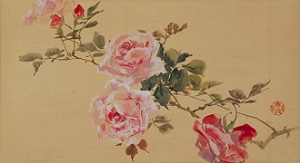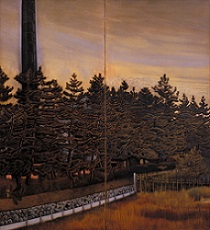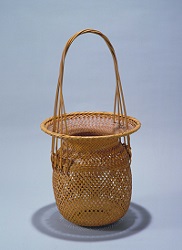Collection GalleryThe 1st Collection Gallery Exhibition 2016–2017 (151 works in all)
Collection Gallery
HOME > Collection Gallery > The 1st Collection Gallery Exhibition 2016–2017
The 1st Collection Gallery Exhibition 2016–2017 (151 works in all)
Exhibition Period
3. 24 (Thu.) – 5. 29 (Sun.), 2016
First Period : 3. 24 (Thu.) – 4. 24 (Sun.), 2016
Second Period : 4. 26 (Tue.) – 5. 29 (Sun.), 2016
Overview
The first collection gallery exhibition of this fiscal year features exhibits with a variety of themes, including works depicting seasonal flowers and works of 3 artists whose commemorative years of birth or death coincide with this year.
At the entrance to the Collection Gallery, in accordance with the title of the exhibits, "Fascination with Roses," a number of works depicting roses are on display. Even though roses suggest the image of western flowers, wild roses are in actuality flowers indigenous to Japan, and are even cited in the 7th-8th century anthology of Japanese poetry entitled "Man'yoshu (Collection of Ten Thousand Leaves)." Roses first became popular in the Meiji period when selectively bred roses were brought to Japan from the West, and although they had seldom been chosen as a subject for painting until then, their figurative beauty soon attracted painters, who started to choose them as the subject of their still-life paintings. In copperplate prints by Hasegawa Kiyoshi, roses symbolize "love" and "beauty." Visitors will be able to enjoy the appeal of roses exemplified through various media such as oil paintings, prints and ceramics.

The section entitled "Spring Scenery in Japanese-style Paintings" features paintings depicting various early- to late-blossoming spring flowers. The exhibits are divided into two exhibition periods. In the first period, paintings centering on cherry blossoms and typical spring scenes, including the paintings "Merry Young Girils in the Seasons of Cherry-blossoms" by Uemura Shoen and "Cherry Lips" by Kikuchi Keigetsu are being featured. In the second period, various flowers such as peonies, wisterias, irises and azaleas which were depicted by such painters as Murakami Kagaku, Tamamura Hokuto and Ishizaki Koyo are displayed.
The Japanese-style Paintings section also presents "Special Feature: The 120th Anniversary of the Birth: Ito Hakudai." Born in the Nakagyo ward of Kyoto in 1896, Ito Hakudai graduated from Kyoto Municipal School of Art and Crafts and Kyoto City Specialist School of Painting. He received an honorable mention with his painting entitled "Rows of Pine Trees" in the 2nd exhibition of the National Creative Painting Association. Although his staunch production style, which focused on realism, was highly evaluated, he died at the young age of 36. Many of his drawings and sketches are included in the collections of our museum. Viewing Hakudai's sketches featuring both the downtown area and outskirts of Kyoto, such as Rokkakudo and Uzumasa, together with the exhibits entitled "On the Streets of Kyoto – Watercolor in 1900s" will enhance one's understanding of the concept of "realism" pursued by Hakudai, which transcended the mere depiction of scenes, in front of the backdrop of the Romanticism movement of Taisho period.

In the Crafts Section, under the title of "Wood and Bamboo: Intrinsic Beauty," selected works of wood and bamboo crafts are introduced. In particular, we feature the woodwork of Takeuchi Hekigai in commemoration of the 120th anniversary of his birth. Born in Fukui prefecture, Hekigai studied in Kyoto and was exquisitely skilled in the many and diverse woodworking techniques, both modern and ancient, centering on imported wooden cabinet works. With a profound knowledge and understanding of woodwork, he created a large number of fabulous works made of wood. Visitors will be able to enjoy the quintessence of his artwork, together with works of other wood and bamboo craft artists of the same period.

Furthermore, we also feature the works of the talented textile artist, Ogo Tomonosuke, in commemoration of the 50th anniversary of his death. Born in the Nakagyo ward of Kyoto in 1898, Ogo Tomonosuke studied Japanese-style painting under Tsuji Kako. Later, in order to innovate dyeing designs, he became a dyer after studying batik techniques, presenting his works at both the Bunten and Nitten exhibitions. While teaching younger students at Kyoto Municipal School of Art (present Kyoto City University of Arts), he continued to create in the déformer style of expression based on accurate sketching, extracting vitality and vigor of plants, water, sky and earth in his works. His innovative expression still maintains a great appeal.
The issue of two-dimensionality and three-dimensionality in paintings has been discussed in various ways since the establishment of linear perspective. In the exhibits entitled "〇△口 (circle, triangle, square)" we try to ascertain how modern and contemporary painters have tackled this matter, focusing on these three basic figures.

Our collection contains not only works of art, but also related materials and literature, such as letters and writings by artists. In the section entitled "Paper Bag & Letter," we try to show some interesting examples of each medium, together with works by Ida Shoichi, created under the theme of "Paper Work."
Themes of Exhibition
- ・〇△口(circle・triangle・square)
- ・Fascination with Roses
- ・Spring Scenery in Japanese-style Painting
- ・120th Anniversary of the Birth: ITO Hakudai
- ・Paper Bag & Letter
- ・Wood and Bamboo: Intrinsic Beauty
- ・On the Streets of Kyoto: Watercolor in 1900s
- ・50th Anniversary of the Death of Dyer OGO Tomonosuke
- ・[Outside] Outdoor Sculptures
List of Works
The 1st Collection Gallery Exhibition 2016–2017 (First Period)
The 1st Collection Gallery Exhibition 2016–2017 (Second Period)


